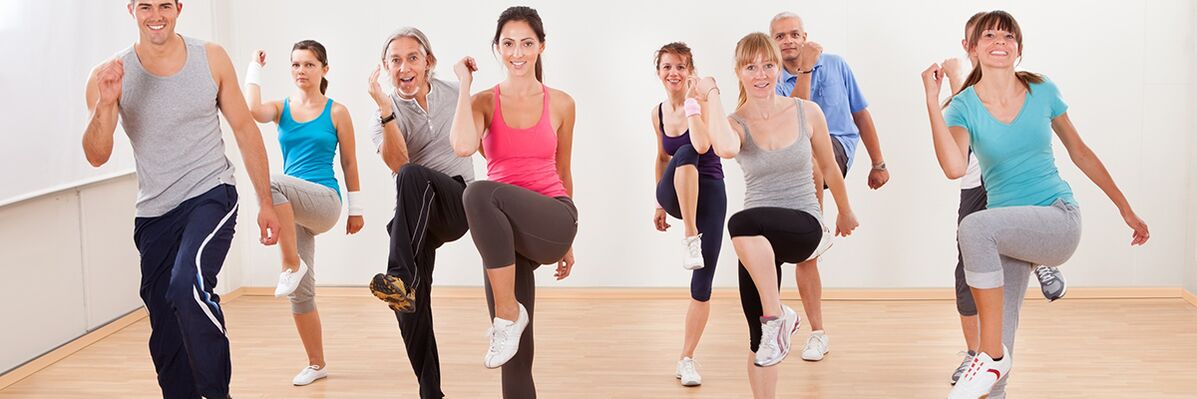
Have you noticed that your legs start to feel numb quickly? And then you have to knead them in a long and unpleasant way?
Do your legs often swell and hurt for no apparent reason?
Perhaps the skin on the legs is covered with an irritating meshwork of blood vessels?
At least one affirmative answer, and you're at risk. Most likely, you have varicose veins in your lower extremities. Due to this disease, the veins increase and this already leads to a violation of blood flow: part of the blood passes from the deep vessels to the superficial ones.
There are even disappointing statistics in this regard. According to him, in developed countries, 30% of women and 10% of men suffer from the disease. And these are just the ones that have reached the doctors. As he can imagine, the numbers are actually much higher, especially among people over the age of 50.
Varicose veins begin with mild discomfort and do not cause serious problems. This is how sneaky it is. For "such nonsense" I do not want to go to the doctor, and the disease, meanwhile, progresses. The skin gradually darkens, the blood vessels swell like cords, and even trophic ulcers appear. Blood clots appear in the affected veins, which subsequently enter other organs and alter blood circulation in them. As a result, a lethal outcome is possible.
Have you ever thought that you can die from simple varicose veins?
People don't think about this. And it would be worth it.
After all, all this is easy to avoid - you just need to consult a phlebologist in time. You will develop a detailed complex treatment program, and exercise will occupy an important place in it.
Let's face it, not all types of workouts are equally beneficial. Some exercises will ease vein pain, while others will seriously make your condition worse. Until urgent hospitalization.
Agree, it is worth distinguishing one from the other.
In this article we will tell you in detail about the effective treatment of varicose veins through gymnastics.
But wait, you might panic early. You may not have varicose veins at all. Now let's compare your situation with the main signs of varicose veins.
How to recognize varicose veins, even if they are just starting
Some of the signs are visible to the naked eye, others can only be felt. Let's start with the external manifestation.
There are four main ones:
- Cobwebs from blood vessels appear on the skin, most often red, blue, or purple.
- The veins become very swollen, it looks like a stretched rope under the skin.
- Brown spots appear on the lower legs.
- The legs swell up in the afternoons.
Another group of symptoms is not externally visible, but causes discomfort:
- Cramps and burning in the legs.
- Feeling of heaviness and pain.
- Itching near a distended vein.
- Severe pain after standing or sitting for a long time.
As you can see, varicose veins manifest in different ways. But even if you don't suffer from cramps and aches, this is no reason to delay visiting the doctor. The longer you wait, the more the disease will progress. Someday, medical care will not be an option, but an urgent need.
Therefore, if you come across some of the signs of varicose veins on your legs, immediately contact a phlebologist.
But what if in the near future you just can't go to the doctor? And the consequences of varicose veins scare you. Or the cramps, burning, pain and heaviness in your legs got you so bad that you already feel like climbing the wall. We will tell you how to help yourself in such a situation.
Varicose Vein Discomfort Will Decrease If You Follow These 7 Proven Recommendations
Let's talk about the minus right away: these techniques don't give an instant effect. Although we would like that very much. But at least they gradually reduce the discomfort of varicose veins. Here are 7 tips:
- Do gymnastics as often as possible.. . . Any exercise is good for blood circulation. Except maybe lifting heavy weights and running. But we are getting ahead of ourselves.
- Wear compression stockings. . . Supports the walls of blood vessels and relieves pressure on them. The swelling and tightness decrease, the legs relax.
- Do not sit or stand in one place for a long time - walk every hour.This will put extra pressure on the veins in your legs and prevent blood from pooling. If you are on your feet while working, try to sit regularly for a few minutes. With legs raised. If you're sitting for a long time, get up and walk for at least a few minutes every hour to get your legs pumping blood back to your heart. The same goes for road trips - stop every 45-60 minutes for a short ride.
- Do not stand near open flames or hot radiators.This impairs blood circulation.
- Eat less salty foods. . . Salt in the body interferes with the circulation of fluids.
- Take a relaxing bath at the beginning of the day, not at the end.. . . And it is better to do without them completely.
- Do not sleep sitting. . . In this position, blood circulation is difficult. Place your legs in a horizontal position to reduce stress on the vessels.
Remember, even strict adherence to our advice will not cure you of varicose veins. Contact a phlebologist - this is the only way to get rid of diseased vessels forever.
The doctor will inform you about the following steps: sometimes it is taking medication, sometimes a painless and quick operation, but always the treatment is accompanied by a change in lifestyle and exercise. We only talk about lifestyle. Now we are going to show you the most effective exercises.
These exercises will alleviate the symptoms of varicose veins, slow its development, and prevent complications.
The expansion of the blood vessels is due in large part to the stagnation of the blood. Therapeutic leg exercises for varicose veins and edema help lower blood pressure and maintain blood circulation. It also improves the tone of the venous walls, so that even with increased pressure, the vessels will not expand.
The choice of exercise depends on the stage of the disease. But in any case, follow the motto "it is better to walk and lie down than to sit and stand".
Walking, running, biking, and swimming are beneficial. The easiest way to walk is to engage the calf muscles, improving blood circulation. Change positions frequently and lift your legs.
If your legs have not yet become entangled with thick varicose veins and only the initial signs of the disease are visible, the following actions will be helpful:
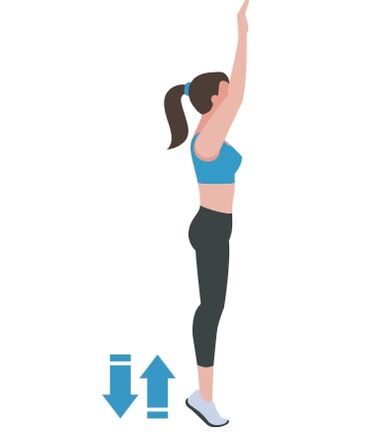 |
Stand on your toes and then slowly lower your heels until they touch the ground. Stand on your toes again and repeat the exercise. |
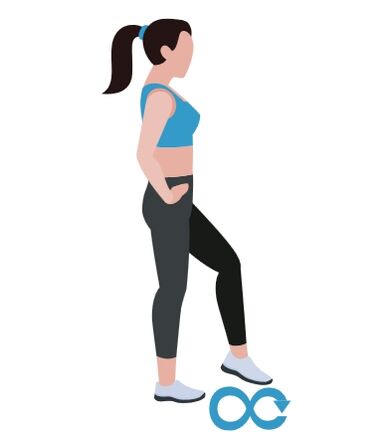 |
He raises his left leg and moves it, as if describing an eight. Repeat this with your right foot. |
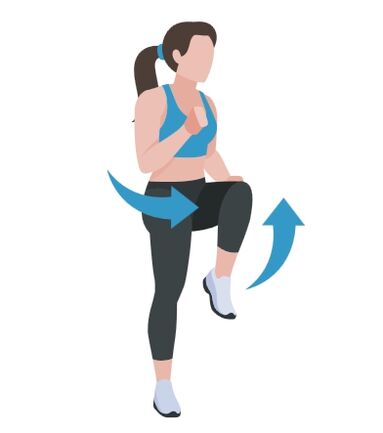 |
March in place and wave your arms vigorously. Raise your knees as high as possible, up to waist level. |
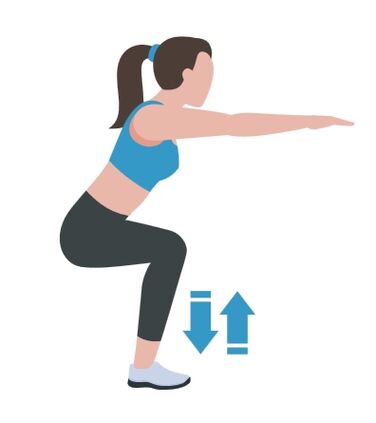 |
Stand up straight and stretch your arms in front of you. Sit slowly. Make sure your knees don't go over the edge of your feet. |
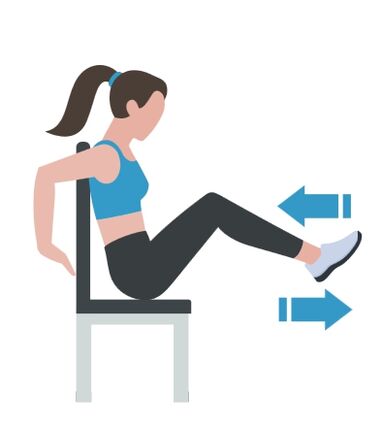 |
Sit down and place your hands behind the back of the chair. Raise your legs toward your torso and then extend them forward. |
In fact, its actions are aimed at improving blood circulation in the lower extremities.
Now let's see how to work with the feet: this is an elementary exercise and it does not require a lot of effort or a lot of time.
This is how you do it:
- Lie down or sit with your feet above your knees.
- Use your fingertips like a brush and draw a circle in the air. Don't move your entire leg, just your ankle.
- Pull the sock towards you to the limit. You will feel heat in your calf muscle.
- Straighten your toes and lower your heels by moving your calf muscles.
- Turn your feet, first outward and then toward the other.
- Repeat the exercise several times.
You do not need special equipment for such activities. Take a seat on your favorite sofa, lift your legs and exercise your joints. Do not forget to exercise for varicose veins regularly so that you can easily improve your blood circulation.
We have an even more effective set of workouts: with it you will stretch the muscles and joints not only in the legs, but also in other parts of the body. But this will require more time to find it. If this is not possible, stop at the previous exercises. If you can get extra minutes, it turns out that you do the ones described above and more this complex.
Still, it stimulates blood circulation throughout the body, not just the legs.
Activities for the neck and head:
- We make circular movements with the head: 10 in one direction and 10 in the other. Move slowly, feel your neck muscles working.
- We pull the chin to the chest 3-4 times, then we pull the back of the head back, the same 3-4 times. Also slowly and carefully.
Exercises for shoulders and arms:
- We make circular movements with the shoulders forward and then back. We move our shoulders slowly, we pull our muscles.
- We straighten our arms and perform circular movements. You don't have to shake them like a windmill. Maintain a speed of 2 rpm. Don't hold your breath.
Lower back exercises:
- Put your hands on your belt. Roll your lower back all the way to one side and then the other side 10 times.
- Lean forward and backward. Keep your feet in one place.
Leg activities:Do 10 squats slowly. Additional weight cannot be used.
Press classes:
- Lie on your back and move your legs like pedaling: exercise a bicycle.
- Perform twists while lying down.
We completely forget to talk about sports. But we are asked about this more often. The most rewarding sport for you is swimming. When immersed in water, the pressure in the circulatory system returns to normal. Swimming is beneficial not only for the heart, but also for the immune and nervous systems. It also strengthens the leg muscles.
What about another sport? Is it possible, for example, to run?
Not all exercises are good for your blood vessels. Let's move on to those who can seriously harm you.
What exercises kill all the result of the treatment of varicose veins?
Let's say you are the ideal patient. Follow all the doctor's orders: take medicine, wear compression underwear, change your lifestyle. Symptoms of the disease gradually disappear. You rejoice, the doctor rejoices.
And then you think, why not consolidate the result with regular training? And to completely forget about varicose veins and train your legs, you decide to squat with a good load.
Bad idea. Now all the work has gone down the drain. Your blood vessels will expand even more than before.
What's the matter?
There are a number of exercises that increase the load on the veins and destroy them if the vascular walls are weakened:
- Strength exercises.
- Weighted squats.
- Prolonged use of the exercise bike.
- Jumping high and long.
- Running on a hard surface.
No amount of treatment will help if you continue to run or lift weights regularly in the gym. Therefore, do not tempt fate.
5 powerful accelerators of your recovery from varicose veins
Yes, they are commonplace. We have already talked about some of them. But trust me, they are really important and worth repeating.
If you've already turned to a phlebologist and started vascular treatment, these 5 tips will help you regain your health faster:
- Do not sit or stand in the same position for long periods of time. It is especially dangerous to cross your legs, this interferes with blood circulation.
- Do the recommended exercises regularly, walk more, and wear comfortable shoes.
- Wear compression stockings selected by your doctor.
- Check your weight. In obese people, the load on the venous system increases.
- After doing the exercises, lie on your back and prop your feet against the wall so that they are above your head. This will allow the blood to drain from the legs.
But this is not a panacea. Again, these recommendations only help in combination with treatment. Without the help of a doctor, you will not be able to cope with the disease.
By the way, do you remember that we talked about the symptoms of varicose veins? Let's say you found them. But only a phlebologist can make an accurate diagnosis. Remember, treatment begins with a correct diagnosis.
Where to get a varicose vein diagnosis
The accuracy of the diagnosis of varicose veins of the lower extremities depends on the clinic team. During the examination of patients, doctors perform a duplex ultrasound with angio scan. It is a quick and painless method of examining superficial and deep vessels.
The doctor clearly sees the problem area of the veins and the obstacles to the movement of the blood. Quickly identify weakened venous valves.
The study allows the phlebologist to obtain accurate information about the vessels and to develop a detailed treatment plan.
But the diagnosis is only the beginning. Any patient needs treatment first. It is important who will carry it out and with what equipment.












































